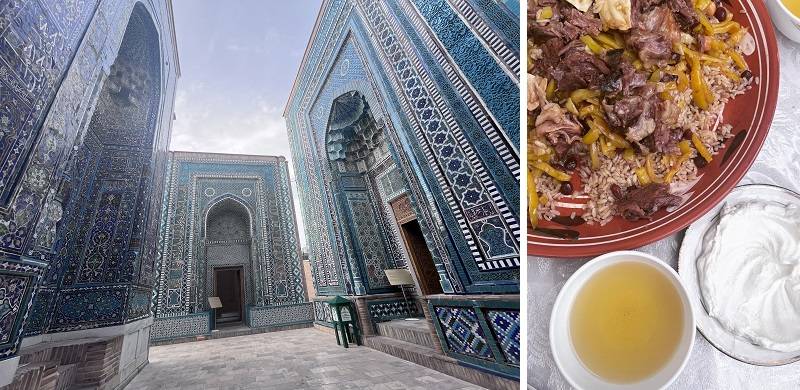
Travelling through Central Asia the last few decades has been one of the side benefits of my professional career. Conversations during meetings meander into Mullah Nasruddin’s truisms. You can walk through a street of chai khanas (tea houses) and gosht khanas (butchers) or end the evening with lengthy dinners built around storytelling and historical fables. Listening to tales of the Silk Road is to be hypnotised by the language and imagery. I could have been at home in Pakistan.
I have grown up listening to fairy tales of maternal ancestors who had migrated from Samarkand and Iran. A recent visit to Uzbekistan made me feel I was returning to my roots. I sensed a strong cultural affinity and bond, not just because of the portly, thick-ankled Uzbek women who resembled so many of my distant aunts, but because I experienced the same values of open hospitality and welcoming culture.
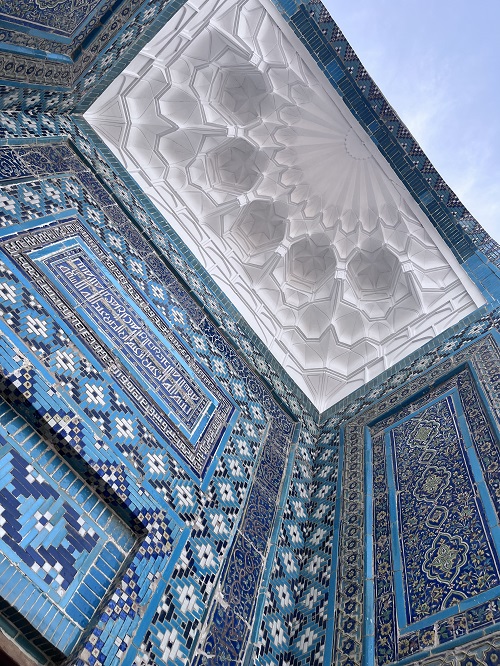 The first time I visited Tashkent over twenty years ago was after its independence from Soviet rule. One could see remnants of Soviet influence in the 1970s-style architecture or in Russian goods – caviar and vodka – easily available in the bazaars. Over time, the pre-Soviet Islamic heritage has come more to the fore and in some ways, it is like visiting a place where old fairy tales of princesses and viziers have been resurrected.
The first time I visited Tashkent over twenty years ago was after its independence from Soviet rule. One could see remnants of Soviet influence in the 1970s-style architecture or in Russian goods – caviar and vodka – easily available in the bazaars. Over time, the pre-Soviet Islamic heritage has come more to the fore and in some ways, it is like visiting a place where old fairy tales of princesses and viziers have been resurrected.
The cultural similarities are striking. The monuments at Ucch – sadly a shadow of the glory that once was – are distant echoes of the red brick and vivid turquoise tile work that we associate with Samarkand.
Samarkand itself is such an evocative name. It was one of the oldest inhabited cities and certainly the largest in Central Asia. It enjoyed a strategic geopolitical advantage – located at the crossroads of the Silk Road between China, Persia and then Europe. Like many old cities, it clings to its own identity – whether it be the old squares and mosques that still house madrassas or in the leafy campus of a more modern university.
Islamic renaissance history, arts and crafts – whether wood carving or embroidery or pottery – and Samarkand plov should be on everyone’s bucket list.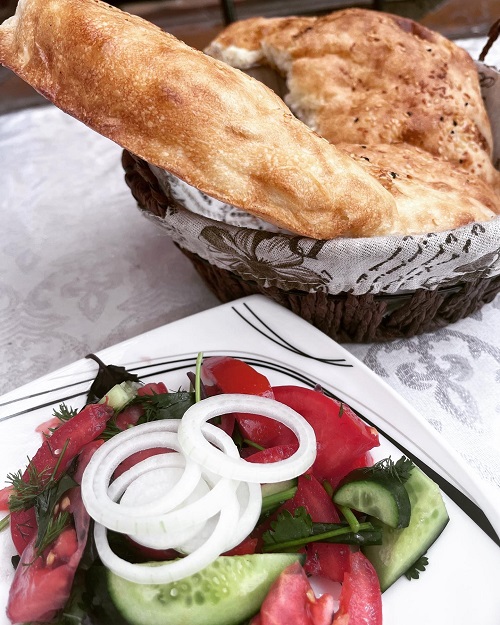
My Uzbek colleague’s wife Nergis took me to an old dargah set behind the main mosque where people still come and pray – rather like the shrines we have in Southern Punjab and Sindh. During Soviet times, Islam was not allowed and religion and rituals were practiced behind closed doors. She recalled how the circumcision of boys would need to be kept secret and done in the sanctity of home, whereas now, even though religion is coming into the open, there is still a mixed opinion as to the role of religion in public life.
After Friday prayers, the ritual of eating at home (usually plov) is similar to ours. Though I have had plov in many areas of the world, there was something other worldly about the Samarkand version. Rumour had it that Alexander had first ordered his chefs to make it as a filling campaign meal for his soldiers. Though this invention has clearly travelled, the attention to detail in the Samarkand version is incredible.
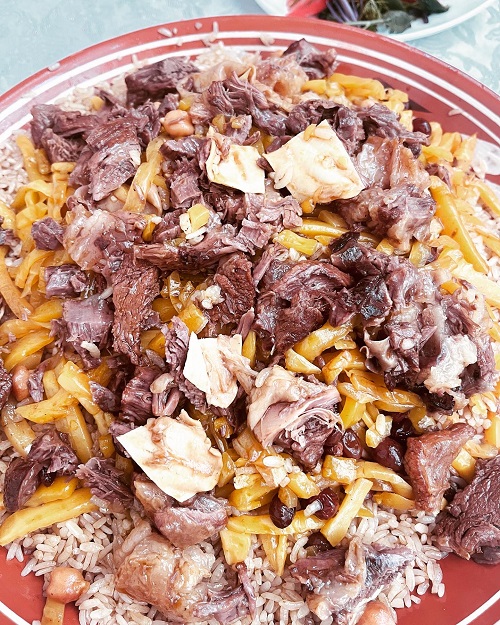 Ulugbek, my Uzbek colleague named after the astronomer king, promised me a meal I would never forget. Before we left our meetings in Samarkand, I had the privilege of going to his favourite local eatery where the family has been going for generations. For that hour, I got a whiff of Uzbek hospitality culture and community at its best.
Ulugbek, my Uzbek colleague named after the astronomer king, promised me a meal I would never forget. Before we left our meetings in Samarkand, I had the privilege of going to his favourite local eatery where the family has been going for generations. For that hour, I got a whiff of Uzbek hospitality culture and community at its best.
I walked into an open kitchen where the master chef in the Kazan supervises four open cauldrons a day until the food is finished.
The Kazan was designed for scale – it would probably feed 50 people easily. The smell was incredible – the fragrant air full of aromas of carrots, raisins and rice all intermingled and bubbling in harmony. One could inhale these before choosing what to have for lunch.
The menu itself was simple – a simple lagan (ceramic plate) is placed in the middle of the table with plov. It was accompanied by freshly cut tomatoes and red onions, strained yoghurt and green tea to digest the lamb fat. In the olden days, one could wash one’s hands in rose water after prayers and settle down to a meal fit for kings.
I could barely bring myself to dislocate the layers – the plov was served in layers – with rice layered with the yellow carrots that make Samarkand plov distinctive.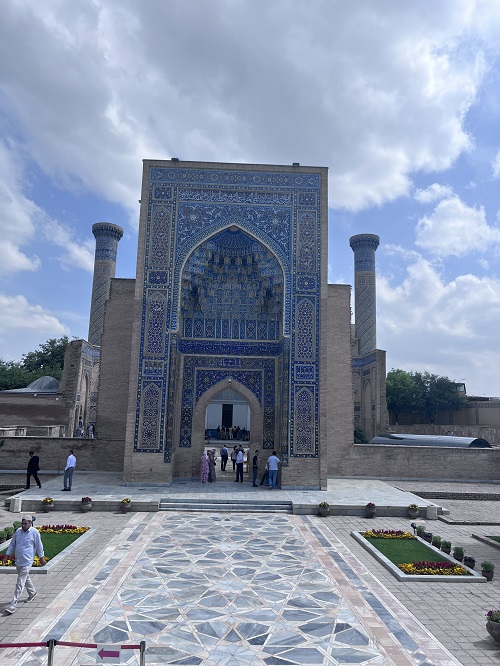
Eating this meal inducted me into an epic tradition that has spanned centuries. And indeed if one goes back in time and reads the accounts of travellers of the 19th century, their experience sounds remarkably similar.
Vambery, who travelled Central Asia almost 150 years ago, described it thus:
“My pilgrim travellers always gave brilliant proofs of their bon ton. My only wonder was that they could support the heavy pilov – for upon occasion I reckoned that each of them had devoured one pound of fat from the tail of the sheep, two pounds of rice, without taking into account bread, carrots, turnips and radishes.”
Though we had probably consumed about a pound of meat and lamb each, the lightly scented green tea helped us recover in time to see Bibi Khanum’s mosque and wander the Samarkand bazaar.
James Elroy Flecker had written about the Golden Journey to Samarkand in his verse play and it was as if that world came to life:
Walking through these bazaars and seeing faces that resembled those of Uzbek miniatures and the strong features of the old bring imagination to life. Even now looking at the monuments, one feels the force of time when Samarkand was born or Afrasiab in the late 7th century BC and when Timur ruled it during the 14th and 15th centuries AD. The city still retains its grandeur and as one perfection of architectural splendours of the Islamic world.
The names sound familiar – whether the grandness of the Registan Square and adjoining madrassas, the Shakhi Zinda compound, the Bibi Khanum mosque or the mausoleums of Gur- Emir and Rukhabad.
This was the land that spawned magical tales of our part of the world. These walls and their designs clearly exerted artistic influence over the world whether in Persia through the Safavids, moving towards the Ottomans in Turkey and even beyond to the Mughals in South Asia.
While walking through the streets of Samarkand, I wondered what it would have been like to have been a pilgrim traveller in those times – to be assailed by new sights, strange sounds and unusual fragrances. It realised that I too, like them, was wedded to the other worldliness of Samarkand. Samarkand plov with its golden carrots and comforting flavours is now part of my travel dowry.
I have grown up listening to fairy tales of maternal ancestors who had migrated from Samarkand and Iran. A recent visit to Uzbekistan made me feel I was returning to my roots. I sensed a strong cultural affinity and bond, not just because of the portly, thick-ankled Uzbek women who resembled so many of my distant aunts, but because I experienced the same values of open hospitality and welcoming culture.
 The first time I visited Tashkent over twenty years ago was after its independence from Soviet rule. One could see remnants of Soviet influence in the 1970s-style architecture or in Russian goods – caviar and vodka – easily available in the bazaars. Over time, the pre-Soviet Islamic heritage has come more to the fore and in some ways, it is like visiting a place where old fairy tales of princesses and viziers have been resurrected.
The first time I visited Tashkent over twenty years ago was after its independence from Soviet rule. One could see remnants of Soviet influence in the 1970s-style architecture or in Russian goods – caviar and vodka – easily available in the bazaars. Over time, the pre-Soviet Islamic heritage has come more to the fore and in some ways, it is like visiting a place where old fairy tales of princesses and viziers have been resurrected.The cultural similarities are striking. The monuments at Ucch – sadly a shadow of the glory that once was – are distant echoes of the red brick and vivid turquoise tile work that we associate with Samarkand.
Samarkand itself is such an evocative name. It was one of the oldest inhabited cities and certainly the largest in Central Asia. It enjoyed a strategic geopolitical advantage – located at the crossroads of the Silk Road between China, Persia and then Europe. Like many old cities, it clings to its own identity – whether it be the old squares and mosques that still house madrassas or in the leafy campus of a more modern university.
Islamic renaissance history, arts and crafts – whether wood carving or embroidery or pottery – and Samarkand plov should be on everyone’s bucket list.

My Uzbek colleague’s wife Nergis took me to an old dargah set behind the main mosque where people still come and pray – rather like the shrines we have in Southern Punjab and Sindh. During Soviet times, Islam was not allowed and religion and rituals were practiced behind closed doors. She recalled how the circumcision of boys would need to be kept secret and done in the sanctity of home, whereas now, even though religion is coming into the open, there is still a mixed opinion as to the role of religion in public life.
After Friday prayers, the ritual of eating at home (usually plov) is similar to ours. Though I have had plov in many areas of the world, there was something other worldly about the Samarkand version. Rumour had it that Alexander had first ordered his chefs to make it as a filling campaign meal for his soldiers. Though this invention has clearly travelled, the attention to detail in the Samarkand version is incredible.
 Ulugbek, my Uzbek colleague named after the astronomer king, promised me a meal I would never forget. Before we left our meetings in Samarkand, I had the privilege of going to his favourite local eatery where the family has been going for generations. For that hour, I got a whiff of Uzbek hospitality culture and community at its best.
Ulugbek, my Uzbek colleague named after the astronomer king, promised me a meal I would never forget. Before we left our meetings in Samarkand, I had the privilege of going to his favourite local eatery where the family has been going for generations. For that hour, I got a whiff of Uzbek hospitality culture and community at its best.I walked into an open kitchen where the master chef in the Kazan supervises four open cauldrons a day until the food is finished.
The Kazan was designed for scale – it would probably feed 50 people easily. The smell was incredible – the fragrant air full of aromas of carrots, raisins and rice all intermingled and bubbling in harmony. One could inhale these before choosing what to have for lunch.
The menu itself was simple – a simple lagan (ceramic plate) is placed in the middle of the table with plov. It was accompanied by freshly cut tomatoes and red onions, strained yoghurt and green tea to digest the lamb fat. In the olden days, one could wash one’s hands in rose water after prayers and settle down to a meal fit for kings.
I could barely bring myself to dislocate the layers – the plov was served in layers – with rice layered with the yellow carrots that make Samarkand plov distinctive.

Eating this meal inducted me into an epic tradition that has spanned centuries. And indeed if one goes back in time and reads the accounts of travellers of the 19th century, their experience sounds remarkably similar.
Vambery, who travelled Central Asia almost 150 years ago, described it thus:
“My pilgrim travellers always gave brilliant proofs of their bon ton. My only wonder was that they could support the heavy pilov – for upon occasion I reckoned that each of them had devoured one pound of fat from the tail of the sheep, two pounds of rice, without taking into account bread, carrots, turnips and radishes.”
Though we had probably consumed about a pound of meat and lamb each, the lightly scented green tea helped us recover in time to see Bibi Khanum’s mosque and wander the Samarkand bazaar.
James Elroy Flecker had written about the Golden Journey to Samarkand in his verse play and it was as if that world came to life:
“What shall we tell you? Tales, marvellous tales
Of ships and stars and isles where good men rest
Where nevermore the rose of sunset pales
And winds and shadows fall towards the West
And where the world’s first huge white bearded kings
In dim glades sleeping, murmur in their sleep.”
Walking through these bazaars and seeing faces that resembled those of Uzbek miniatures and the strong features of the old bring imagination to life. Even now looking at the monuments, one feels the force of time when Samarkand was born or Afrasiab in the late 7th century BC and when Timur ruled it during the 14th and 15th centuries AD. The city still retains its grandeur and as one perfection of architectural splendours of the Islamic world.
The names sound familiar – whether the grandness of the Registan Square and adjoining madrassas, the Shakhi Zinda compound, the Bibi Khanum mosque or the mausoleums of Gur- Emir and Rukhabad.
This was the land that spawned magical tales of our part of the world. These walls and their designs clearly exerted artistic influence over the world whether in Persia through the Safavids, moving towards the Ottomans in Turkey and even beyond to the Mughals in South Asia.
While walking through the streets of Samarkand, I wondered what it would have been like to have been a pilgrim traveller in those times – to be assailed by new sights, strange sounds and unusual fragrances. It realised that I too, like them, was wedded to the other worldliness of Samarkand. Samarkand plov with its golden carrots and comforting flavours is now part of my travel dowry.

